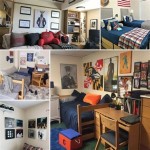How To Decorate a Small TV Room
Decorating a small TV room presents unique challenges. Maximizing space while maintaining a comfortable and aesthetically pleasing environment requires careful planning and execution. This article offers practical advice on how to achieve this balance, focusing on furniture selection, color palettes, lighting, and strategic décor placement.
Furniture Selection and Placement: The foundation of a well-decorated small TV room lies in choosing the right furniture and placing it strategically. Opt for multi-functional pieces. A storage ottoman can serve as a footrest and a place to store blankets and remotes. Consider a wall-mounted TV console to free up floor space. Choose furniture with a smaller footprint. Sleek, streamlined designs are preferable to bulky, oversized pieces. Arrange furniture to create a clear pathway and avoid overcrowding the room. Leave sufficient space between seating and the television for comfortable viewing.
Color Palette and Wall Treatments: Light, neutral colors create an illusion of spaciousness. Whites, creams, and pastels reflect light, making the room feel larger and brighter. Consider using a slightly darker shade for an accent wall to add depth and visual interest without overwhelming the space. Vertical stripes can create the illusion of higher ceilings. Avoid busy wallpaper patterns, which can make a small room feel cluttered. Mirrors are a powerful tool for expanding a space visually. Place a large mirror strategically to reflect light and create a sense of depth.
Lighting Strategies for Small Spaces: Layered lighting is essential in a small TV room. Relying solely on overhead lighting can create harsh shadows and make the room feel smaller. Incorporate a combination of ambient, task, and accent lighting. Ambient lighting provides overall illumination, while task lighting is directed towards specific areas, such as reading corners. Accent lighting highlights artwork or architectural features. Floor lamps and table lamps can add warmth and create a cozy atmosphere. Install dimmer switches to control the intensity of the light and adjust the ambiance according to the time of day and activity.
Window Treatments and Natural Light: Maximize natural light to make the room feel larger and more inviting. Choose sheer curtains or blinds that allow light to filter through while still providing privacy. Avoid heavy drapes that block light and make the room feel closed in. If privacy is a concern, consider using blinds with adjustable slats or layering sheer curtains with heavier drapes that can be drawn when needed.
Storage Solutions for a Clutter-Free Environment: Clutter can quickly overwhelm a small space. Incorporate smart storage solutions to keep the room organized and tidy. Utilize vertical space with wall-mounted shelves or tall bookcases. Choose furniture with built-in storage, such as ottomans with hidden compartments or coffee tables with drawers. Baskets and decorative boxes can be used to store remotes, magazines, and other small items. Keep surfaces clear of clutter to maintain a sense of order and spaciousness.
Decorative Accents and Accessories: While minimalism is often recommended for small spaces, it doesn’t mean the room should be devoid of personality. Incorporate decorative accents and accessories strategically to add visual interest and warmth. Choose a few carefully selected pieces, such as artwork, throw pillows, or a decorative rug. Avoid overcrowding the room with too many accessories. Select items that complement the color scheme and overall style of the room. A large piece of artwork can serve as a focal point and draw the eye upwards, making the room feel larger.
Creating Zones within the Space: If the TV room serves multiple purposes, consider creating distinct zones within the space. A small reading nook can be created with a comfortable armchair and a floor lamp. A small work area can be carved out with a compact desk and a comfortable chair. Use rugs to define different areas and create visual separation. This helps to maximize the functionality of the room without making it feel cluttered.
Technology Integration and Cable Management: Technology is an integral part of a TV room, but exposed cables and wires can create a cluttered and unsightly appearance. Implement effective cable management solutions to keep cords organized and hidden. Use cable ties or clips to bundle wires together and route them behind furniture or along baseboards. Consider using a cable management box to conceal power strips and excess cords. Wall-mounting the television can also help to minimize visible cables.
Regular Decluttering and Maintenance: Maintaining a clutter-free environment is essential in a small TV room. Regularly declutter the space and remove any unnecessary items. Keep surfaces clear and organized. This will help to maintain a sense of spaciousness and prevent the room from feeling overwhelmed. Regular cleaning and maintenance will also contribute to a more inviting and comfortable environment.

20 Small Tv Room Ideas That Balance Style With Functionality

20 Small Tv Room Ideas That Balance Style With Functionality
:max_bytes(150000):strip_icc()/CASSPhoto_JND_Annisipour_087-6a89d9a7b702485bb76523071d89fc6f.jpg?strip=all)
42 Tv Room Ideas For Binge Watching In Comfort And Style

20 Small Tv Room Ideas That Balance Style With Functionality Furniture Placement Living Design

Living Room Layout With Tv Ideas Full Of Style Comfort Homilo

11 Tv Room Ideas For Limited Spaces Designcafe

20 Small Tv Room Ideas That Balance Style With Functionality

How To Pick The Right Tv For Smaller Living Rooms My Beautiful Adventures

Small Room Design And Ideas For A Modern Lifestyle Founterior

12 Designer Small Living Room Ideas With Tv Havenly Blog Interior Design
Related Posts







